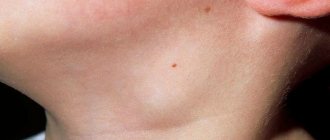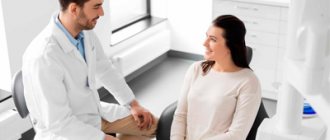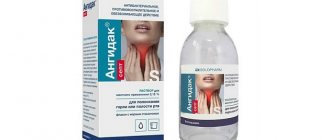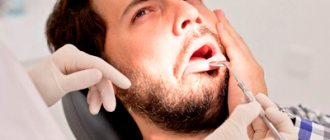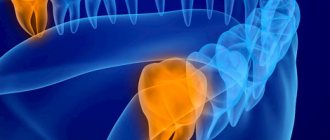Lymphadenitis (inflammation of the lymph nodes) is an acute or chronic inflammation of the lymph nodes, which can be caused by both cancer and infectious diseases. Antibiotics for swollen lymph nodes are used to treat a bacterial infection. To identify the root cause, histological methods, physical examination data and laboratory blood tests are used. The prognosis depends on the patient’s health status, concomitant diseases and the nature of lymphadenitis. Antibiotics are not always required for swollen lymph nodes.
Features of the disease
Lymphadenitis is a very common pathology, during which inflammation develops in the lymph nodes.
To understand the etiology of the disease, it is necessary to understand in more detail the physiological processes occurring in the human body. Lymph nodes represent a kind of barrier that restrains the spread of pathogenic microflora from the nearest focus of the inflammatory process throughout the system. However, there are cases when the lymph node itself becomes a source of infection in the event of suppuration. As a result, patients often require hospitalization and possibly surgery. It is quite difficult to obtain statistical data regarding the prevalence of pathology. The fact is that the disease often becomes a complication of other pathologies, for example, tonsillitis or purulent wounds, and its course is not very difficult. In such situations, therapy is aimed at the underlying disease, and lymphadenitis disappears without specific treatment. Therefore, patients with a very serious degree of pathology, which already requires serious medical and often surgical intervention, turn to a specialist.
Causes of pathology
As already indicated, in the vast majority of cases, inflammation occurs as a complication after an infectious process that has already been suffered.
This occurs for physiological reasons, when pathogens are carried by the lymph current to the nearest lymph node. If the body functions correctly and appropriate therapy is carried out, then the bacteria arrive there already in a weakened or killed state, or die directly in it. In this case, inflammation does not develop further. However, if the process is not stopped and the pathogen is very active, then inflammation is already developing in the node itself. In such a situation, lymphadenitis is secondary. However, there are cases when the pathology is primary.
This can occur as a result of trauma to the lymph node area, during which the strain penetrates through the site of injury. It should be noted that such pathologies are very rare and occur against the background of reduced immune defense. The cause of nonspecific lymphadenitis in most cases is staphylococcal and streptococcal infections .
The nodes enter through the flow of blood or lymph. The most common foci of primary inflammation include: carbuncles, boils, infected wounds, thrombophlebitis, osteomyelitis and others. A specific type of pathology is caused by a special type of pathogen that provokes the appearance of specific diseases, for example, gonorrhea, syphilis, tuberculosis, plague, anthrax and others. In such situations, the localization of the inflammatory process occurs in the node closest to the site of infection. So, in case of a sexually transmitted disease, the inguinal nodes are the first to react.
Antibiotics for inflammation of the lymph nodes
To understand which antibiotics should be used for a particular pathology, it is necessary to pay attention to certain factors. There is clinical evidence that in most cases, nonspecific lymphadenitis is caused by streptococcal and staphylococcal microorganisms. That is why it is customary to prescribe antimicrobial agents that are most effective against them.
In addition, it is necessary to take into account the severity of the disease, the patient’s age and the presence of concomitant pathologies. Despite the fact that lymphadenitis has a very clear clinical picture, its features vary somewhat from patient to patient. Elderly people, young children and patients with chronic decompensated conditions are very prone to the formation of sepsis, which may well be fatal. Therefore, in such situations, a more powerful medication, or a combination of both, is often prescribed.
A characteristic feature of each type of antibiotic is the place where they accumulate. Due to the characteristics of the disease, it is preferable to use a product with a concentration in the human lymphatic system. For the best effect, it is also recommended to take into account the patient’s medical history and medication history. If a few months ago the patient already underwent antimicrobial therapy, then it is necessary to select a drug from a different group.
Modern tactics for treating pathology involve dividing drugs into first and second lines. Initially, safer drugs with a broad spectrum of action are prescribed. However, if they turn out to be ineffective or cause an allergic reaction, then you have to move on to second-line drugs.
For lymphadenitis use:
- penicillins;
- cephalosporins;
- macrolides;
- fluoroquinolones;
- lincosamides;
- aminoglycosides.
Penicillins
This class of antimicrobial agents was found earlier than others and has been widely used in medical practice for many decades. They have a very wide spectrum of bactericidal effects. However, due to long-term use, many pathogens have developed resistance to these medications.
Erysipelas due to lymphedema
Erysipelas is a bacterial hypodermal cellulitis that is usually associated with streptococcal infection. Most often it is a complication of chronic lymphedema. The first signs are a sudden rise in temperature and chills. The clinical feature is an inflammatory dermatitis with clearly defined boundaries, which is often accompanied by fever. Inflammatory skin thickening contributes to lymph stagnation and the progression of lymphedema.
Erysipelas, as such, is mainly treated with antibiotics. Relapse prevention is an important goal. Because lymphedema is a major risk factor for recurrence, aggressive treatment is necessary.
Risk factors for erysipelas
The lymphatic system plays an important role in protecting the body from infection. Stagnation of lymph during lymphedema contributes to the penetration of infection into dilated lymphatic capillaries. Infectious complications are mainly bacterial, most often erysipelas (cellulitis), and sometimes lymphangitis (inflammation of the lymphatic vessels). The most common causative agent of erysipelas is β-hemolytic streptococcus (groups A, C, G). Bacterial complications are facilitated by the abundance of proteins characteristic of edema in lymphatic insufficiency associated with obstructed lymphatic drainage. This high protein content in the interstitial fluid provides an ideal breeding ground for bacterial growth.
Erysipelas is a dermo-hypodermal bacterial infection without involvement of the superficial aponeurosis. Erysipelas complicates lymphedema in 30% of cases and aggravates its course.
With lymphedema, chronic inflammation of the skin is very common; it may not be associated with infection, but only with stagnation of lymph. However, the presence of streptococcus in changed skin is always a risk factor for erysipelas. And the use of hormonal ointments on the skin of patients with lymphedema can provoke deep purulent-necrotic damage to the subcutaneous tissue and fascia.
Symptoms
Erysipelas often occurs suddenly, with pronounced systemic signs - fever >38 ° 5, chills and general malaise. Local signs develop within a few hours: redness, local fever, pain and rapid spread of the lesion, with centrifugal expansion over several days. Erysipelas can begin at any stage of lymphedema and can spread to all or part of the changed skin tissue.
Diagnosis
The diagnosis of erysipelas is established clinically:
The sudden onset of an inflammatory lesion that spreads over several days, preceded or accompanied by fever and chills, as well as general malaise.
Streptococcus is isolated only from 4% to 35% of cases in patients with erysipelas. If the most sophisticated methods are used (immunofluorescence, polymerase chain reaction), then streptococcus is isolated with a frequency of 70% to 80%.
Differential diagnosis
Erysipelas must be differentiated from other infections sometimes seen with lymphedema, such as lymphangitis, most often streptococcal (less commonly staphylococcal) or necrotizing fasciitis (most often streptococcal).
Lymphangitis is characterized by the appearance of an inflammatory streak (red, hot and painful) along the superficial lymphatic vessels (which themselves are satellites of the superficial venous system). Accompanied by fever. There is no spread of the lesion into deep tissues.
Other acute forms of dermo-hypodermal bacterial infections are caused by Erysipelotrix rhusiopathiae (swine erysipelas), the bacterium pasteurella multocida, and borrelia borgdorferi. They have a less inflammatory and febrile clinical presentation without the typical chronology of erysipelas.
Thus, the diagnosis of erysipelas is purely clinical in nature and does not require any laboratory tests, in particular bacteriological ones.
Treatment
Antibacterial treatment is carried out with amoxicillin tablets (3-4.5 g/day, in 3 doses) for two weeks.
Hospitalization is necessary if:
- There is doubt about the diagnosis, or there are serious systemic features, comorbidities, or a social context that makes home treatment impossible for the patient.
- Fever persists for more than 72 hours. In such cases, treatment is carried out with intravenous penicillin g (10-20 million units in 4-6 infusions per day).
Relapse Prevention
Erysipelas with lymphedema often recurs and aggravates its course. To avoid recurrence of erysipelas, treatment is carried out with long-acting penicillins. (Extencillin or Retarpen 1 gram per week for 4 weeks during a possible exacerbation).
Treatment of lymphedema using conservative and surgical methods, maintaining the disease without progression helps reduce the likelihood of relapses of erysipelas.
Rules for taking antibacterial drugs
Antibiotics are among a number of drugs, the use of which is strictly prohibited without a doctor’s prescription, as they can lead to the development of serious side effects. In addition, the choice of antibacterial agent depends on the pathogen, so the patient cannot choose it independently.
Antimicrobial drugs are prescribed for lymphadenitis in a course. The minimum duration of therapy is five days, the maximum is four weeks. It is prohibited to discontinue the drug before completing the full course, because this can lead to a worsening of the condition and the development of sepsis.
It is advisable to take the antibiotic at the same time, so that equal intervals are maintained between doses. If for any reason the time was missed, then the tablet must be taken as soon as possible and then continue the course as usual. You can take the drug only with clean water; any other liquid can affect the absorption of the active substance.
When is antibiotic therapy required?
First of all, you need to see a therapist
Antibiotics for severe inflammation of the lymph nodes are prescribed by a lymphologist, immunologist, oncologist or endocrinologist. First, you always need to contact your family doctor, who will write a referral to a specialist.
For patients with lymphadenitis (inflammation of the lymph nodes), treatment depends on the pathogen and may include watchful waiting, antibiotic therapy, chemotherapy and radiotherapy. Waiting is used when the lymph nodes are smaller than 3 cm, are not characterized by redness of the skin and have been present for less than 2 weeks.
Antibiotics for severe inflammation of the lymph nodes in the neck are used when the lymph nodes are more than 2-3 cm in size, thicken only on one side, and are characterized by excessive pain and redness. Antibiotics should target common infectious causes of lymphadenopathy: Staphylococcus aureus and streptococci.
Due to the increasing prevalence of methicillin-resistant Staphylococcus aureus, antibiotic therapy with Clindamycin is recommended for enlarged lymph nodes.
What antibiotics can you take during pregnancy?
The period of waiting for the birth of a child is very important in the life of every mother, and the main task of the therapist when prescribing treatment is the safety of the fetus and the woman. Therefore, it is necessary to clearly understand what is prescribed for inflammation of the lymph nodes during pregnancy and lactation.
In most cases, penicillins are used for antimicrobial therapy. They are allowed to be used at any stage of pregnancy, including the first trimester. However, the prescription must have clearly defined indications.
For infections of the respiratory tract, urinary system and ENT organs, beta-lactam antibiotics and cephalosporins are used in most cases. In some cases, the use of Erythromycin is permitted.
What antibiotics are prescribed for children?
Lymphadenitis in children develops in childhood in most cases as a result of infectious lesions of the respiratory tract, and they, in turn, are accompanied by respiratory viruses.
Uncontrolled use of antimicrobial agents for respiratory infections in children often leads to the emergence of antibiotic resistance. Due to the improper use of antibiotics, children may experience dyspeptic symptoms. In severe cases, it can lead to acute liver failure, enterocolitis or erythema multiforme.
Prescription of antibiotics is necessary for:
- bacterial pneumonia;
- meningitis;
- infections of the genitourinary system;
- purulent tonsillitis.
In childhood, the use of Cefuroxime and Amoxicillin is permitted. The first is used to destroy streptococcus, pneumococcus and staphylococcus, which often cause inflammation of the throat and mouth. The second belongs to the class of penicillins and is widely used in the treatment of tonsillitis, infections of the ears, nose and throat, as well as inflammation in bone tissue and the bloodstream.
What antibiotics treat lymphadenitis?
Antibiotics are synthesized chemical compounds or metabolic products of molds, streptomycetes or bacteria that are used to treat bacterial diseases. Antibiotics support the immune system in the fight against pathogenic bacteria. There are various substances, the most important of which are:
- Broad-spectrum penicillins.
- Penicillins with a narrow spectrum of action.
- Fluoroquinolones.
- Lincosamides.
- Macrolides.
- Aminoglycosides.
The effect of antibiotics varies. The goals of drugs may be to inhibit cell wall synthesis (penicillins, cephalosporins), change the permeability of the cell membrane, inhibit the synthesis of DNA and RNA bacteria (aminoglycosides, tetracyclines or macrolides, antimetabolites).
When using antibiotics, you must first determine the type of bacterial infection. Many diseases are caused primarily by a single pathogen. Sometimes it is necessary to conduct a bacteriological analysis and exclude antibiotic resistance. Only then can the target drug be selected.
The antibiotic should be taken for the period and dose prescribed by the doctor. This is very important even if the symptoms disappear before the end of therapy. If you stop taking an antibiotic early in the disease, some bacteria may survive and cause complications. Some patients quickly develop resistant bacterial strains that, if they become ill again, no longer respond to the antibiotic used.
An example of inappropriate use of antibiotics is prescribing drugs too quickly for fever. Fever is the body's natural response to illness, which can have many different causes. If it is caused by a bacterial infection, antibiotic therapy is required. Antibiotics are often prescribed to treat enlarged lymph nodes in the neck due to a cold or bronchitis, which are usually caused by viruses. Antibiotics are ineffective against viruses.
Such drugs for chronic enlargement of the lymph nodes in the neck can also be used for preventive purposes. It is prohibited to take prophylactic antibiotics without a doctor's recommendation. As a rule, drugs are prescribed before surgery on the digestive tract or before implantation of prostheses.
The choice of drug depends on the causative agent of inflammation
Penicillins
Penicillin and its derivatives have a bactericidal effect. Penicillins interfere with the synthesis of the cell wall of prokaryotes by blocking a specific enzyme. Since humans and animals do not have cell walls, penicillin only acts on the cell walls of bacteria. Phenoxymethylpenicillin and penicillin G are examples of drugs with a narrow spectrum of action. Amoxicillin is a broad-spectrum antibiotic.
Penicillins are prescribed for lymphadenitis caused by respiratory tract infections (sinusitis, pharyngitis, tonsillitis, bronchitis and pneumonia). Most often, penicillin drugs are prescribed to pregnant women and young children. They effectively eliminate the infectious pathogen and, therefore, lymphadenitis. Penicillins often cause allergic reactions, taste changes, vomiting, nausea, diarrhea, agitation, anxiety, leukopenia and tachycardia.
The most common representatives of penicillin antibiotics:
- Amoxicillin.
- Ampicillin.
- Phenoxymethylpenicillin.
Amoxicillin is prescribed in a dose of 250-500 mg once for people over 10 years of age and weighing more than 40 kg. The drug must be taken twice a day every 8-10 hours. In severe cases, it is recommended to increase the dosage. The average cost of Amoxicillin is 80 Russian rubles. Ampicillin is prescribed in a daily dose of 1-3 g. The dosage can be increased after consultation with a doctor. It is recommended to take the drug three times a day at equal intervals. The average cost of a medicine is 50 Russian rubles.
Aminoglycosides
Aminoglycosides are toxic to the kidneys
Aminoglycosides bind to the 30s subunit of bacterial ribosomes and disrupt protein biosynthesis. As a result, not only the correct amino acids are introduced into the protein, but also the incorrect ones. This leads to the formation of proteins with a defective amino acid sequence. The defective proteins cannot be used by the bacterium, so it dies. Aminoglycoside antibiotics have a bactericidal effect.
Important representatives of the aminoglycoside group:
- Streptomycin.
- Tobramycin.
- Neomycin.
- Netilmicin.
- Gentamicin.
- Amikacin.
- Kanamycin.
- Spectinomycin.
- Hygromycin.
- Apramycin.
Aminoglycosides have a narrow therapeutic index. Side effects include nephrotoxicity and ototoxicity, so drugs are recommended to be taken in limited dosage.
Streptomycin is prescribed for lymphadenitis in a single dose of 0.5-1 g. The daily dosage should not exceed 1-2 g. The average cost of Streptomycin is 500 Russian rubles. The daily dose of Neomycin is 0.4 g. It is recommended to take the drug 2 times a day. The average cost of Neomycin is 300 Russian rubles.
Fluoroquinolones
Fluoroquinolones inhibit DNA gyrase and topoisomerase-4. The mechanical energy stored in the bacterial chromosome decreases, and the length of the chromosome increases. As a result, bacterial DNA can no longer be replicated correctly. The growth of bacteria stops (bacteriostatic effect), then the cells die (bactericidal effect). However, inhibition of DNA replication cannot adequately explain the bactericidal effect of fluoroquinolones. Newer members are also effective against bacterial topoisomerase enzymes.
Fluoroquinolones have a very broad spectrum of activity against most gram-negative and gram-positive bacteria, some anaerobes and various antibiotic-resistant streptococci. Fluoroquinolones are used for all bacterial infections of the urinary tract and upper respiratory tract.
Fluoroquinolones include:
- Enoxacin.
- Norfloxacin.
- Ciprofloxacin.
- Ofloxacin.
- Levofloxacin.
- Moxifloxacin.
- Nadifloxacin.
- Lomefloxacin.
During fluoroquinolone treatment, 4-10% of patients experience side effects. According to recent studies, the incidence of adverse reactions is 25-30%. The increase in the incidence of side effects is explained by the tightening of clinical trial criteria for assessing the potential of new fluoroquinolones. The most common adverse reactions are gastrointestinal disorders - nausea and diarrhea. Mental disorders are less common.
The recommended daily dose of Enoxacin is 400 mg. The drug can be taken 2 times a day, 200 mg. The average cost is 300 Russian rubles. The average daily dosage of Norfloxacin is 800 mg. The drug can also be divided into two single doses. The average market price is 250 Russian rubles.
Lincosamides
Among the advantages of the drug is its affordable cost
Lincosamides include Lincomycin and Clindamycin. Lincomycin cannot be used to treat upper or lower respiratory tract infections. Therefore, in such cases, only Clindamycin is used. It primarily has a bacteriostatic, time-dependent effect on staphylococci, streptococci, corynebacteria and mycoplasma. The possibility of cross-antibiotic resistance with macrolides must be taken into account.
Lincosamides bind to the 50S subunit of bacterial ribosomes and lead to the dissociation of peptidyl transferase from ribosomes. The drugs inhibit the biosynthesis of proteins in bacteria. Therefore, lincosamides have a bacteriostatic effect. Clindamycin also has some activity against protozoa and is therefore used to treat toxoplasmosis and malaria. Lincosamides are the class of antibiotics most commonly associated with pseudomembranous colitis.
Lincomycin is used in a daily dose of 0.5 mg, and Clindamycin - 0.6 mg. It is recommended to take the drugs 4 times a day. The average cost of Lincomycin is 93 Russian rubles, and Clindamycin is 400 rubles.
Macrolides
Macrolides are antibiotic agents that inhibit protein synthesis in bacteria. The oldest representatives are Erythromycin, more modern medicinal substances are Clarithromycin, Azithromycin or Roxithromycin. Tylosin is currently approved for veterinary use only.
Macrolides are used against almost all bacterial infections in the respiratory tract. They are also the drug of choice against two sexually transmitted diseases that often occur together: gonorrhea and chlamydia. In addition, they are used against skin infections caused by staphylococci.
Macrolides, in addition to β-lactams, are considered well-tolerated antibiotics. They may cause mild gastrointestinal upset or reversible hearing loss. Erythromycin may also be used during pregnancy.
The drugs are taken orally in tablet form. The new drugs are better absorbed than Erythromycin, remain longer in the body and are more effective. Macrolides are partially eliminated from the body through the liver, and sometimes through the kidneys. However, macrolides are not suitable for the treatment of urinary tract infections. They can also interfere with the excretion of other drugs that are acidic and are excreted from the body through the kidneys (acetylsalicylic acid, uric acid, thiazide diuretics, penicillins, sulfonamides).
Macrolides are not among the most effective antibiotics and are therefore not suitable for the treatment of complex infections (eg in the intensive care unit). Because they inhibit only one specific enzyme, bacteria quickly develop resistance to macrolides.
The recommended dose of Clarithromycin for adults and children over 12 years of age is 250 mg 2 times a day. It is recommended to maintain a 12-hour interval between doses. Clarithromycin costs about 250 rubles at the pharmacy. Azithromycin is taken in a daily dose of 500 mg. The medicine can be taken 1 time per day. The average cost is 250 rubles.
